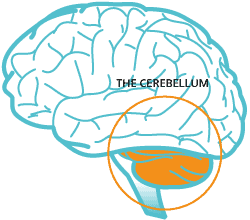This month, we sat down with Dr. Ron to learn more about the importance of this often overlooked structure to understand the role it plays in how and why iLs programs are so effective.
What is the cerebellum?

The cerebellum is tucked into the back of the brain. It is massively connected to the motor cortex and also to areas involved in attention, language, planning and even emotion.
Cerebellum means “little brain.” Sadly, most physicians and scientists still only know about its role in the control of balance and gross motor movements. But the role of the cerebellum goes far beyond these basic functions.
The cerebellum is a brain structure that illustrates very well the dynamic interconnectedness of the brain. While we use a sort of shorthand to describe the specific functions of certain brain areas, no one area could complete its job without coordinating with many other areas. The cerebellum is an important, though behind-the-scenes, organizer of much of our movement and behavior.
As an example, think of reaching out to pick up a glass of water on the table. This seemingly simple action is actually quite complex. You have to reach your arm the right distance for your hand to connect with the glass. You have to perceive the width of the glass to know how wide to open your fingers to grasp it. And you have to use the right amount of pressure to lift the glass – too little and you won’t be able to raise the glass, but too much and you will jerk the glass up too quickly and likely spill the water. All of these calculations are made outside of your awareness and the cerebellum coordinates them all.
How did you become so enamored with the cerebellum?
Well, like the Oracle of Delphi, the cerebellum answered many clinical questions that had plagued me for a long time. Questions such as: “Why did so many young boys with dyslexia only begin to read after they learned to ride a bike or throw and catch a ball with accuracy but not before?” Or, “Why, when balance and coordination improved, did language, organization and planning and emotional regulation also finally improve?” I learned that it’s not just gross motor movements the cerebellum orchestrates. The cerebellum has vast connections to all parts of the brain. This includes brain areas that perform higher brain functions, such as reading, language, and even emotional regulation. The cerebellum also responds to and learns to anticipate rewards. This involvement in the reward response makes it important in motivation and behavior.
Do iLs programs affect the cerebellum?
Yes, most definitely. Improving cerebellar function is central to working with learning difficulties, language disorders, autism, sensory processing disorder and head injury. And because iLs involves simultaneous, multi-sensory input, it directly stimulates the cerebellum. Sensory stimulation (balance, proprioceptive, auditory, visual and touch) is gradually increased to gently train the cerebellum to become more efficient at processing multiple inputs. This is, in part, due to the fact that 90% of the input to the cerebellum is sensory and only 10% is motor. As processing efficiency improves, the body and motor functions become more organized, information is processed more easily, learning is less demanding and behavior is better regulated. I’ve always said that body organization is necessary for brain organization. The cerebellum is the conduit between the two since it connects to every part of the brain. What’s not to love about the cerebellum?!



 © 2024 Unyte Health US Inc.
© 2024 Unyte Health US Inc.